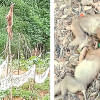We must stop wildlife trafficking

It is worrying to know that Chattogram has emerged as a transit route for wildlife trafficking. This has been confirmed after police, according to a report, seized several consignments of animals while being smuggled from the hilly areas of Bandarban and Khagrachhari via Chattogram. Several criminal rackets are said to be active around the region, using lax monitoring and ingenious methods to smuggle endangered species including hoolock gibbons, porcupines, fishing cats, leopard cats, and Kalij pheasants. Despite the danger that traffickers pose to our diminishing wildlife number, it is clear that the response of the authorities has been quite inadequate.
According to some officials, smugglers collect animals from the deep forests of Ali Kadam, Naikhongchhari, Rowangchhari, Chattogram's Banshkhali, and Lohagara's Chunti. They are then transported to the port city via Satkania and Lohagara or Chakaria. Two recent seizures by police have brought to light how this works – involving an intricate, multi-layered process of poaching, collecting, smuggling and selling, both at home and abroad, via transnational syndicates – eventually contributing to a multi-billion-dollar global business. Although police occasionally seize consignments of animals and animal parts, and arrest low-level criminals involved in carrying them, the ringleaders always remain untouched.
The extent of the danger that wildlife faces as a result can be understood from an official estimate that says that a total of 425 animals were smuggled to Chattogram from different areas in the 2021-2022 fiscal year. Chattogram being a route has a strategic significance for both domestic and overseas transportation, but it is neither the only route nor are forests in the division the only poaching hotspots. Given how unprotected our forests are across the country, and how lax the monitoring of forest offices and local administrations is, it is safe to assume the problem is much more widespread.
We must admit, however, that the fight against illegal wildlife trade is not easy. As well as novel methods being used by field-level collectors, carriers and smugglers, those behind the trade are also increasingly using modern communication tools to connect with customers. Facebook, for example, remains a thriving marketplace for wild animals despite the tech giant's pledge to help combat the trade. The involvement of affluent, powerful collectors makes it even harder to prevent. One may recall the rescue of three capped langurs from the bungalow of a lawmaker, who reportedly kept them caged for four years, violating the Wildlife Conservation Act-2012. No legal action was taken against him.
The wildlife trade is thriving because of the involvement of such powerful benefactors as well as the failure of relevant authorities to take effective measures. This is all the more unfortunate at a time when our wildlife population is facing a multidimensional existential crisis with their natural habitats – forests, hills and forest lands – being gobbled up, often by state agencies themselves, under various pretexts. We must stop this trend. The government must take stringent measures to stop the illegal wildlife trade.


 For all latest news, follow The Daily Star's Google News channel.
For all latest news, follow The Daily Star's Google News channel. 








Comments